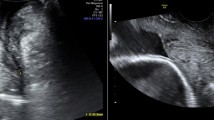Abstract
Objective
The aim was to evaluate the agreement between and the reproducibility of transperineal and transvaginal ultrasound cervical length measurements performed by the duty obstetrical team in case of preterm labor. The acceptability of transperineal ultrasonography was also assessed.
Methods
Pregnant patients between 25 and 34 weeks of gestation with contractions and a clinically modified cervix were included. Order of ultrasonography examination (transperineal or transvaginal first) and rank of operator (resident or senior) were allocated randomly. Agreement was assessed using the intraclass correlation coefficient (ICC) and the Bland and Altman plot. The patient’s discomfort and preference for either method were assessed with a questionnaire.
Results
62 patients admitted for preterm labor between 25 and 34 weeks of gestation were included. Six seniors and nine residents took part in the study. Among the 51 patients with an interpretable transperineal ultrasound scan, median cervical length measurements with the transperineal and the transvaginal technique were, respectively, 25 mm (0–53) and 27 mm (4–51). Concordance was good with an ICC of 0.83 [IC 95 % = (0.73–0.90)]. Transperineal ultrasonography was preferred in 56.5 % of cases.
Conclusion
In case of preterm labor, cervical length measurement with transperineal ultrasonography seems reproducible and can be performed by the obstetric team on duty.


Similar content being viewed by others
References
Iams JD, Goldenberg RL, Meis PJ, Mercer BM, Moawad A, Das A, Thom E, McNellis D, Copper RL, Johnson F, Roberts JM (1996) The length of the cervix and the risk of spontaneous premature delivery. National Institute of Child Health and Human Development Maternal Fetal Medicine Unit Network. N Engl J Med 334:567–572
Meijer-Hoogeveen M, Stoutenbeek P, Visser GH (2006) Methods of sonographic cervical length measurement in pregnancy: a review of the literature. J Matern Fetal Neonatal Med 19:755–762
Berghella V, Baxter JK, Hendrix NW (2013) Cervical assessment by ultrasound for preventing preterm delivery. Cochrane Database Syst Rev 1:CD007235
Heath VC, Southall TR, Souka AP, Elisseou A, Nicolaides KH (1998) Cervical length at 23 weeks of gestation: prediction of spontaneous preterm delivery. Ultrasound Obstet Gynecol 12:312–317
Meijer-Hoogeveen M, Stoutenbeek P, Visser GH (2008) Transperineal versus transvaginal sonographic cervical length measurement in second- and third-trimester pregnancies. Ultrasound Obstet Gynecol 32:657–662
Cicero S, Skentou C, Souka A, To MS, Nicolaides KH (2001) Cervical length at 22–24 weeks of gestation: comparison of transvaginal and transperineal-translabial ultrasonography. Ultrasound Obstet Gynecol 17:335–340
Yazici G, Yildiz A, Tiras MB, Arslan M, Kanik A, Oz U (2004) Comparison of transperineal and transvaginal sonography in predicting preterm delivery. J Clin Ultrasound 32:225–230
Eggebo TM, Gjessing LK, Heien C, Smedvig E, Okland I, Romundstad P, Salvesen KA (2006) Prediction of labor and delivery by transperineal ultrasound in pregnancies with prelabor rupture of membranes at term. Ultrasound Obstet Gynecol 27:387–391
Carr DB, Smith K, Parsons L, Chansky K, Shields LE (2000) Ultrasonography for cervical length measurement: agreement between transvaginal and translabial techniques. Obstet Gynecol 96:554–558
Kurtzman JT, Goldsmith LJ, Gall SA, Spinnato JA (1998) Transvaginal versus transperineal ultrasonography: a blinded comparison in the assessment of cervical length at midgestation. Am J Obstet Gynecol 179:852–857
Owen J, Neely C, Northen A (1999) Transperineal versus endovaginal ultrasonographic examination of the cervix in the midtrimester: a blinded comparison. Am J Obstet Gynecol 181:780–783
Ozdemir I, Demirci F, Yucel O (2005) Transperineal versus transvaginal ultrasonographic evaluation of the cervix at each trimester in normal pregnant women. Aust N Z J Obstet Gynaecol 45:191–194
Bonett DG (2002) Sample size requirements for estimating intraclass correlations with desired precision. Stat Med 21:1331–1335
Shrout PE, Fleiss JL (1979) Intraclass correlations: uses in assessing rater reliability. Psychol Bull 86:420–428
Bland JM, Altman DG (1986) Statistical methods for assessing agreement between two methods of clinical measurement. Lancet 1:307–310
Hertzberg BS, Livingston E, DeLong DM, McNally PJ, Fazekas CK, Kliewer MA (2001) Ultrasonographic evaluation of the cervix: transperineal versus endovaginal imaging. J Ultrasound Med 20:1071–1078
Conflict of interest
The authors report no conflict of interest.
Author information
Authors and Affiliations
Corresponding author
Rights and permissions
About this article
Cite this article
Gauthier, T., Marin, B., Garuchet-Bigot, A. et al. Transperineal versus transvaginal ultrasound cervical length measurement and preterm labor. Arch Gynecol Obstet 290, 465–469 (2014). https://doi.org/10.1007/s00404-014-3229-1
Received:
Accepted:
Published:
Issue Date:
DOI: https://doi.org/10.1007/s00404-014-3229-1




